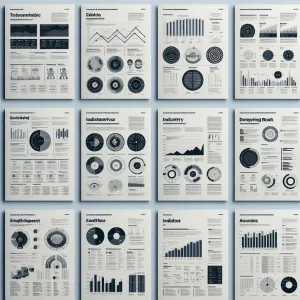In today’s interconnected business environment, organizations increasingly rely on third-party vendors to deliver essential services and products. This reliance has given rise to the need for a robust third party risk management audit program, which is critical for safeguarding an organization’s interests and ensuring compliance with regulatory requirements.
Definition of Third-Party Risk Management
Third-party risk management refers to the systematic process of identifying, assessing, and mitigating risks associated with external vendors and partners. This encompasses a range of activities aimed at understanding the potential threats posed by third parties, including their operational practices, financial stability, and compliance with relevant regulations. Effective third party risk management audit program is essential for organizations to maintain control over their risk exposure and ensure that third-party relationships do not compromise their operational integrity or reputation [8].
Importance of Third-Party Relationships in Modern Business
The significance of third-party relationships cannot be overstated. Organizations often depend on these external partners for critical functions such as supply chain management, IT services, and customer support. As businesses strive for efficiency and cost-effectiveness, the integration of third-party services has become a strategic necessity. However, this dependence also introduces vulnerabilities, making it imperative for organizations to implement comprehensive third party risk management audit programs or strategies to manage these risks effectively [12].
Overview of Common Risks Associated with Third Parties
Engaging with third parties can expose organizations to various risks, including:
- Operational Risks: Disruptions in service delivery from third-party vendors can impact an organization’s operations, leading to potential financial losses and reputational damage.
- Compliance Risks: Third parties may not adhere to regulatory requirements, which can result in legal penalties and compliance issues for the organization.
- Financial Risks: The financial health of third-party vendors is crucial; a vendor’s insolvency can disrupt services and lead to unexpected costs.
- Cybersecurity Risks: Third-party vendors can be a gateway for cyber threats, as they may have access to sensitive data and systems, increasing the risk of data breaches and cyberattacks [11].
Understanding the critical role of third-party risk management and its integration in audit programs is essential for internal auditors and IT audit professionals. By leveraging technology and adopting a proactive approach to TPRM, organizations can enhance their audit programs, ensuring that they effectively mitigate risks associated with third-party relationships.
Understanding the Role of Internal Auditors in Third Party Risk Management
In the realm of third-party risk management (TPRM) audit programs, internal auditors play a crucial role in ensuring that organizations effectively manage the risks associated with their external partnerships. This section will clarify the responsibilities of internal auditors in assessing third-party risks, highlighting their functions, contributions, and the significance of independent assessments.
Definition of Internal Audit Functions
Internal audit functions are designed to provide independent assurance that an organization’s risk management, governance, and internal control processes are operating effectively. These functions typically include:
- Risk Assessment: Identifying and evaluating risks that could impact the organization, including those arising from third-party relationships.
- Control Evaluation: Assessing the adequacy and effectiveness of controls in place to mitigate identified risks.
- Compliance Monitoring: Ensuring that the organization adheres to relevant laws, regulations, and internal policies.
- Advisory Services: Offering insights and recommendations to improve processes and controls related to risk management.
How Internal Auditors Contribute to Third-Party Risk Management
Internal auditors contribute significantly to third party risk management audit programs by:
- Conducting Audits: They perform audits of third-party relationships to evaluate the effectiveness of risk management practices and controls. This includes reviewing contracts, compliance with service level agreements, and the overall performance of third-party vendors [6].
- Identifying Risks: Through their assessments, auditors identify potential risks associated with third-party engagements, such as financial, reputational, and security risks [5].
- Enhancing Oversight: Internal auditors provide oversight by ensuring that third-party risk management processes align with the organization’s broader risk management strategies. This alignment is crucial for maintaining comprehensive control over external risks [10].
- Facilitating Communication: They act as a bridge between various departments, ensuring that all stakeholders are aware of the risks posed by third-party relationships and the measures in place to mitigate them [2].
The Importance of Independent Assessment of Third-Party Relationships
Independent assessments by internal auditors are vital for several reasons:
- Objectivity: Internal auditors provide an unbiased evaluation of third-party risks, which is essential for identifying issues that may not be apparent to those directly involved in the relationships [10].
- Accountability: Their independent reviews hold management accountable for the risks associated with third-party vendors, ensuring that appropriate actions are taken to address any identified weaknesses [9].
- Regulatory Compliance: Many industries are subject to regulations that require independent audits of third-party relationships. Internal auditors help organizations comply with these requirements, thereby reducing the risk of regulatory penalties [11].
- Continuous Improvement: By regularly assessing third-party risk management practices, internal auditors contribute to the continuous improvement of these processes, helping organizations adapt to evolving risks and challenges in the business environment [4].
Internal auditors play a pivotal role in third party risk management audit programs by conducting thorough assessments, identifying risks, and ensuring compliance with regulations. Their independent evaluations are essential for maintaining effective oversight of third-party relationships, ultimately safeguarding the organization from potential external threats.
The Impact of Technology on Third Party Risk Management Audits
In the evolving landscape of internal auditing, technology plays a pivotal role in enhancing the effectiveness and efficiency of third-party risk management audits. As organizations increasingly rely on external vendors and service providers, the need for robust audit processes has never been more critical. Here, we explore how technological advancements are transforming the audit process, making it more streamlined and accurate.
Overview of Technological Advancements Relevant to Audit
Recent advancements in technology have significantly impacted the auditing field, particularly in third-party risk management. Key developments include:
- Data Analytics: The use of data analytics allows auditors to analyze large volumes of data quickly, identifying patterns and anomalies that may indicate potential risks associated with third-party relationships. This capability enhances the auditor’s ability to assess risks more comprehensively and in real-time [2][8].
- Artificial Intelligence (AI): AI tools can automate routine audit tasks, such as data collection and preliminary analysis, freeing up auditors to focus on more complex risk assessments. AI can also assist in predicting potential risks based on historical data, providing valuable insights for auditors [9].
- Cloud Computing: Cloud-based audit management systems facilitate collaboration among audit teams and provide secure access to audit documentation and findings from anywhere. This flexibility is particularly beneficial for audits involving multiple stakeholders across different locations.
Benefits of Technology in Enhancing Audit Efficiency and Accuracy
The integration of technology into third-party risk management audits offers several advantages:
- Increased Efficiency: Automation of repetitive tasks reduces the time auditors spend on manual processes, allowing them to conduct more audits in less time. This efficiency is crucial in a landscape where organizations face increasing regulatory scrutiny and the need for timely risk assessments [12].
- Enhanced Accuracy: Technology minimizes human error by standardizing processes and providing tools for thorough data analysis. This leads to more accurate risk assessments and better-informed decision-making regarding third-party relationships [10][11].
- Improved Risk Identification: Advanced analytics and AI can uncover hidden risks that traditional audit methods might overlook. By leveraging these technologies, auditors can gain a deeper understanding of the risks posed by third-party vendors, including potential cybersecurity threats and compliance issues [8][9].
Examples of Technology Tools Used in Third-Party Risk Audits
Several technology tools are currently being utilized to enhance third-party risk management audits:
- Risk Assessment Software: Tools like RSA Archer and LogicManager help organizations assess and manage risks associated with third-party vendors by providing frameworks for risk evaluation and monitoring [8].
- Continuous Monitoring Solutions: Platforms such as BitSight and SecurityScorecard offer continuous monitoring of third-party vendors’ cybersecurity posture, allowing auditors to stay informed about potential risks in real-time.
- Collaboration Tools: Software like Microsoft Teams and Slack facilitates communication and collaboration among audit teams, ensuring that all members are aligned and informed throughout the audit process [9].
The integration of technology into third party risk management audit programs not only streamlines the audit process but also enhances the overall effectiveness of risk assessments. By embracing these technological advancements, internal auditors and IT audit professionals can better safeguard their organizations against the myriad risks posed by external vendors and service providers.
Streamlining Third Party Risk Assessments through Technology
In the evolving landscape of third-party risk management (TPRM) and audit programs, technology plays a pivotal role in enhancing the efficiency and effectiveness of audits. Internal auditors and IT audit professionals can leverage various technological advancements to streamline risk assessments, ensuring comprehensive oversight and control over external risks. Here are some key points detailing how technology simplifies these processes:
Automated Risk Assessment Tools: Automated tools are essential for conducting thorough risk assessments with greater speed and accuracy. These tools can:
- Identify and Evaluate Risks: They systematically analyze data from various sources to identify potential risks associated with third-party vendors, including cybersecurity threats, compliance issues, and financial instability. This automation reduces the manual workload and minimizes human error, allowing auditors to focus on higher-level analysis and decision-making [9].
- Continuous Monitoring: Many automated tools offer continuous monitoring capabilities, enabling organizations to stay updated on the risk status of their third-party relationships. This proactive approach allows for timely interventions when new risks are identified [10].
The Role of Data Analytics: Data analytics is transforming how auditors evaluate third-party risks. By utilizing advanced analytics, auditors can:
- Analyze Large Data Sets: Data analytics tools can process vast amounts of information from third-party vendors, providing insights into their operational performance, compliance history, and risk exposure. This capability allows for a more nuanced understanding of potential vulnerabilities [6].
- Predictive Analytics: Leveraging predictive analytics can help auditors forecast potential risks based on historical data and trends, enabling organizations to take preemptive actions to mitigate risks before they materialize [9].
Cloud-Based Solutions: The adoption of cloud-based solutions significantly enhances accessibility and collaboration among audit teams. These solutions offer:
- Real-Time Collaboration: Cloud platforms facilitate real-time collaboration among internal audit teams, allowing for seamless communication and information sharing. This is particularly beneficial when assessing risks across multiple third-party vendors, as teams can work together regardless of their physical location [11].
- Centralized Data Storage: Storing risk assessment data in the cloud ensures that all relevant information is easily accessible and up-to-date. This centralization simplifies the audit process, as auditors can quickly retrieve necessary documents and reports without the hassle of managing multiple data sources [12].
The integration of technology into third party risk management audit programs not only streamlines the assessment process but also enhances the overall effectiveness of risk management strategies. By utilizing automated tools, data analytics, and cloud-based solutions, internal auditors can ensure a more robust and responsive approach to managing third-party risks, ultimately safeguarding their organizations against potential vulnerabilities.
Enhancing Data Collection and Analysis for Third Party Audits
In the realm of internal auditing, particularly concerning third-party risk management (TPRM) audit programs, the integration of technology has become increasingly vital. As organizations face mounting pressures to ensure compliance and mitigate risks associated with third-party engagements, leveraging technology can significantly enhance the effectiveness and efficiency of audit processes. Here are some key points to consider regarding how technology improves data handling in audits.
Importance of Comprehensive Data Collection
Comprehensive data collection is foundational to effective third-party risk management audits. It allows auditors to gain a holistic view of the risks associated with third-party relationships. A robust data collection strategy ensures that all relevant information is captured, including vendor performance metrics, compliance records, and risk assessments. This thorough approach not only aids in identifying potential risks but also supports informed decision-making during the audit process.
How Technology Aids in Real-Time Data Analysis
Technology plays a crucial role in facilitating real-time data analysis, which is essential for timely risk assessment and response. Advanced analytics tools and software can process vast amounts of data quickly, enabling auditors to identify trends, anomalies, and potential issues as they arise. For instance, generative AI can be employed to analyze vendor data and flag any discrepancies or compliance issues, allowing auditors to address concerns proactively rather than reactively. This capability enhances the overall audit quality and ensures that organizations can respond swiftly to emerging risks, thereby strengthening their risk management frameworks [1][5].
The integration of technology into third party risk management audit programs is transforming the way internal auditors collect and analyze data. By prioritizing comprehensive data collection, leveraging real-time analytics, and learning from successful case studies, organizations can enhance their audit processes and better manage the risks associated with third-party relationships. This evolution not only improves audit efficiency but also strengthens overall risk management strategies, ensuring that organizations remain compliant and resilient in an increasingly complex risk landscape.
Improving Compliance and Reporting with Technology
In the realm of third-party risk management audits, technology plays a pivotal role in enhancing compliance and reporting processes. As organizations increasingly rely on external vendors and service providers, the need for robust compliance management becomes paramount. Here are several key points illustrating how technology can streamline and improve these audits:
- Integration of Compliance Tools in Audit Processes: The adoption of specialized compliance tools allows internal auditors to seamlessly integrate compliance checks into their audit workflows. These tools can automate the assessment of third-party vendors against regulatory requirements and internal policies, ensuring that compliance is not only maintained but also easily verifiable. This integration helps auditors focus on more strategic tasks rather than getting bogged down in manual compliance checks, thereby increasing efficiency and effectiveness in the audit process [10][11].
- Automated Reporting and Documentation Management: Technology facilitates automated reporting, which significantly reduces the time and effort required to compile audit findings and compliance reports. Automated systems can generate real-time reports that reflect the current status of third-party risk management, making it easier for auditors to present findings to stakeholders. This capability not only enhances the accuracy of reports but also ensures that documentation is consistently maintained and readily accessible, which is crucial for compliance audits [12][14].
- Enhancing Transparency and Traceability through Technology: Utilizing technology in third-party risk management audits enhances transparency and traceability. Advanced audit management software can track changes, document interactions with third-party vendors, and maintain a clear audit trail. This level of transparency is essential for demonstrating compliance to regulatory bodies and internal stakeholders. Furthermore, it allows organizations to quickly respond to any compliance inquiries or audits, thereby reducing potential risks associated with non-compliance [13][15].
The integration of technology into third-party risk management audits not only streamlines compliance processes but also enhances the overall effectiveness of internal audits. By leveraging compliance tools, automating reporting, and improving transparency, internal auditors can better manage risks associated with third-party relationships, ultimately safeguarding their organizations against potential threats.
Challenges and Considerations in Implementing Technology for Audits
As organizations increasingly rely on third-party vendors, the importance of robust third-party risk management audits has never been more critical. Technology plays a pivotal role in streamlining these audits, but its implementation is not without challenges. Here are some key considerations for internal auditors and IT audit professionals when adopting technology for third-party risk management audits:
- Identifying Barriers to Technology Adoption: One of the primary challenges in integrating technology into audit functions is the resistance to change within organizations. Internal auditors may face hurdles such as a lack of training, insufficient resources, or outdated systems that are not compatible with new technologies. Additionally, there may be a cultural reluctance to embrace automation, as some auditors may fear that technology could replace their roles rather than enhance their capabilities. Understanding these barriers is crucial for a successful transition to a technology-driven audit process [1][6].
- Balancing Automation with Human Oversight: While technology can significantly enhance the efficiency of audits through automation, it is essential to maintain a balance between automated processes and human oversight. Automated systems can handle large volumes of data and identify patterns that may not be immediately apparent to human auditors. However, human judgment is still necessary to interpret findings, assess risks, and make informed decisions. Striking the right balance ensures that audits remain thorough and effective while leveraging the strengths of both technology and human expertise [2][7].
- Ensuring Data Security and Privacy Compliance: The integration of technology into third-party risk management audits raises significant concerns regarding data security and privacy compliance. Auditors must ensure that any technology used adheres to relevant regulations and standards, such as GDPR or HIPAA, to protect sensitive information. This includes implementing robust cybersecurity measures and conducting regular assessments of third-party vendors’ security practices. Failure to address these concerns can lead to data breaches and compliance violations, undermining the integrity of the audit process [3][5][8].
While technology offers substantial benefits for third-party risk management audits, internal auditors must navigate various challenges to implement it effectively. By identifying barriers to adoption, balancing automation with human oversight, and ensuring data security and compliance, organizations can enhance their audit processes and better manage third-party risks.
Future Trends in Third Party Risk Management Audits and Technology
As organizations increasingly rely on third-party vendors and service providers, the need for robust third-party risk management (TPRM) audits becomes paramount. The integration of technology into these audits is not just a trend but a necessity that can significantly enhance the efficiency and effectiveness of the auditing process. Here are some key insights into the future trends that are likely to shape TPRM audits, particularly through the lens of technology.
Predicted Advancements in Technology Impacting Audits
The landscape of third-party risk management audits is set to undergo significant transformation due to advancements in technology. By 2025, it is anticipated that over 50% of major enterprises will leverage artificial intelligence (AI) and machine learning (ML) to conduct continuous regulatory compliance checks, thereby streamlining the audit process and enhancing accuracy [11]. This shift from manual to automated insights will not only accelerate decision-making but also reduce human error, providing a more comprehensive view of the third-party landscape [4].
The Role of Artificial Intelligence and Machine Learning
AI and ML are poised to play a crucial role in the future of TPRM audits. These technologies can facilitate real-time screening, monitoring, and evaluation of third parties, allowing auditors to identify potential risks before they materialize [14]. The predictive capabilities of AI will enable organizations to anticipate third-party risks, thereby enhancing their proactive risk management strategies. Furthermore, the integration of AI into risk management frameworks is expected to transform how audits are conducted, making them more efficient and data-driven.
The Importance of Staying Ahead in a Rapidly Evolving Technological Landscape
In a rapidly evolving technological landscape, it is essential for internal auditors and IT audit professionals to stay updated with the latest trends, tools, and best practices in TPRM. Continuous learning and adaptation will be key to effectively managing third-party risks and ensuring compliance with regulatory requirements [5]. As the TPRM landscape evolves, organizations must maintain a laser focus on business resilience, sustainability, and transparency to navigate the complexities of third-party relationships [6].
The future of third-party risk management audits is intricately linked to technological advancements. By embracing AI, ML, and other emerging technologies, internal auditors can enhance their audit programs, ensuring they are well-equipped to address the challenges posed by an increasingly interconnected world. Staying ahead of these trends will be crucial for organizations aiming to mitigate risks and maintain compliance in their third-party engagements.
Conclusion
In today’s rapidly evolving business landscape, the integration of technology into third-party risk management audits has become not just beneficial but essential. The importance of technology in these audits cannot be overstated, as it plays a crucial role in enhancing efficiency, accuracy, and overall effectiveness. By leveraging advanced tools and systems, internal auditors can streamline the audit process, ensuring that all third-party interactions are thoroughly assessed and compliant with regulatory standards.
Key takeaways from our exploration of technology’s role in third-party risk management audits include:
- Enhanced Efficiency: Technology automates many aspects of the audit process, from vendor identification to risk assessment, allowing auditors to focus on strategic analysis rather than manual data collection. This leads to faster turnaround times and more comprehensive audits [2][8].
- Improved Accuracy: Automated systems reduce the likelihood of human error, ensuring that data collected during audits is reliable and precise. This accuracy is vital for making informed decisions regarding third-party relationships [3][12].
- Proactive Risk Management: With the help of technology, organizations can adopt a proactive approach to risk management. Advanced analytics and monitoring tools enable auditors to identify potential risks before they escalate, allowing for timely interventions [4][11].
As we move forward, it is imperative for internal auditors and IT audit professionals to embrace these technological advancements. By adopting innovative tools and methodologies, auditors can significantly improve audit outcomes, ensuring that their organizations are well-protected against the risks associated with third-party vendors.
In conclusion, the call to action is clear: internal auditors must leverage technology to enhance their third-party risk management audit programs. Embracing these tools not only strengthens the audit process but also positions organizations to navigate the complexities of today’s regulatory environment effectively. The future of auditing lies in technology, and those who adapt will undoubtedly lead the way in ensuring robust risk management practices.
Find out more about Shaun Stoltz https://www.shaunstoltz.com/about/
This post was written by an AI and reviewed/edited by a human.



